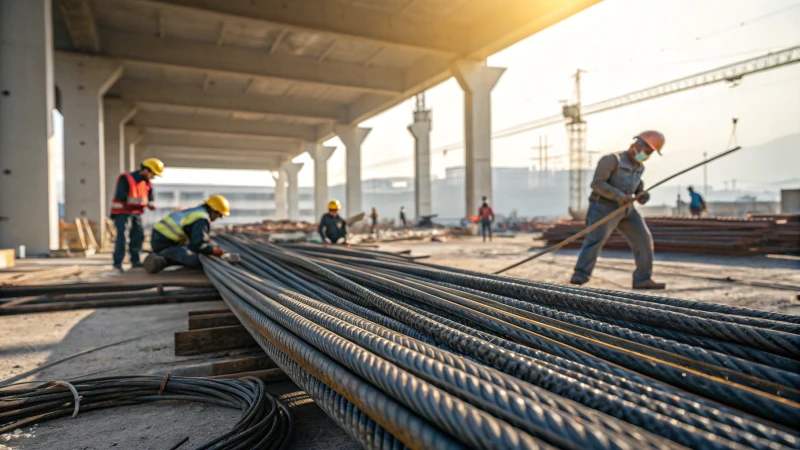
Imagine standing at the foot of a towering crane, pondering the perfect steel wire rope to hoist the heavy load above. Overhead limitations aren't just about height; they're about precision and safety.
Overhead limitations are crucial in steel wire rope selection as they determine the allowable rope length, tensile strength, and weight. Longer ropes risk slackness and friction, hampering efficiency. Thus, ropes made of high-strength, lightweight materials are ideal for optimal performance in such situations.
When I first started working with steel wire ropes, I was amazed by how many factors could influence their selection. It's not just about getting the strongest rope—it's about understanding the constraints of your environment. The overhead limitations play a significant role because they affect not only how much rope you can use but also how it performs under pressure.
I've seen projects where choosing the wrong rope led to inefficiencies and even safety hazards. So, if you're in the position of selecting ropes for your work, considering material choices and industry-specific requirements can make a world of difference. Dive into material innovations and design improvements; it’s fascinating how technology has evolved to help us overcome these challenges.
Overhead limitations dictate rope length.True
Overhead constraints require careful consideration of rope length to ensure safety.
High-strength materials are not preferred under constraints.False
High-strength, lightweight materials are preferred for optimal performance.
What should I consider when choosing wire ropes?
Imagine the pressure of ensuring every lift on a construction site is safe and smooth. That's where selecting the right wire rope comes into play, and I've been there.
When choosing wire ropes, focus on tensile strength, flexibility, fatigue resistance, and environmental durability to ensure they meet your specific operational needs and withstand harsh conditions.
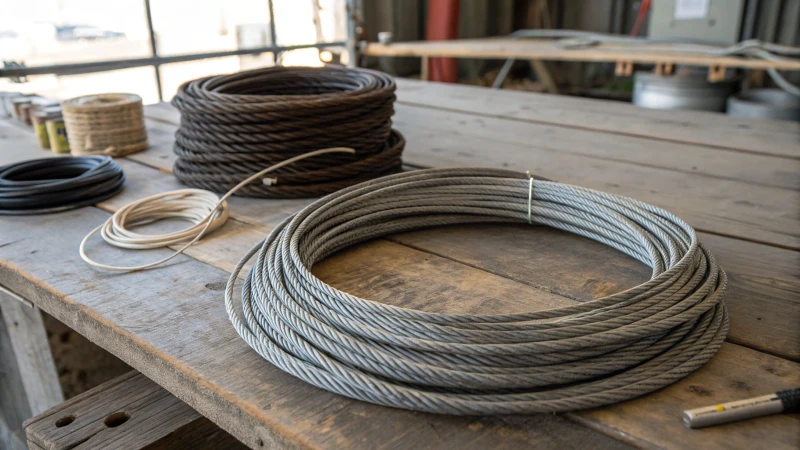
Understanding Tensile Strength
Think of tensile strength as the backbone of your wire rope. It's the silent hero that ensures your loads don't come crashing down. I remember a time when I was overseeing a project, and selecting the right tensile strength was like choosing the right lifeline—it had to be spot on to handle our heavy machinery demands. Aligning this with your operational needs is crucial to avoid any potential disasters.
Tensile strength refers to the maximum load a wire rope can handle without breaking. This factor is pivotal in determining the rope's capacity to support loads in heavy machinery1 and construction equipment. It's essential to match the tensile strength with the operational needs to prevent failures.
Evaluating Flexibility and Fatigue Resistance
Flexibility might not sound like a big deal, but trust me, in applications where bending is a daily affair—like cranes and hoists—it's a game-changer. A flexible rope can save you from those heart-stopping moments when you fear wire breakage. And fatigue resistance? It's like having a rope that won't tire out on you, ensuring longevity even under constant strain. I once worked with a team where we had to replace ropes frequently until we prioritized these factors, which made all the difference.
Flexibility is important for applications requiring frequent bending, such as in cranes and hoists. A more flexible rope reduces the risk of wire breakage due to continuous movement. Additionally, consider fatigue resistance; a rope with high fatigue resistance lasts longer under cyclic loading.
| Factor | Importance |
|---|---|
| Tensile Strength | Ensures the rope can support the intended load |
| Flexibility | Facilitates movement and reduces breakage risk |
| Fatigue Resistance | Extends lifespan under repetitive loading conditions |
Environmental Durability
Wire ropes aren't just about lifting—they're out there braving the elements. In environments filled with moisture, salt, and chemicals, corrosion resistance becomes your best friend. I learned this the hard way during a marine project where our ropes were constantly battling rust. Opting for galvanized or stainless steel ropes saved us from a lot of headaches.
Wire ropes are often exposed to harsh environments, including moisture, salt, and chemicals. Selecting a rope with adequate corrosion resistance is crucial for operations in marine environments2. Galvanized or stainless steel ropes offer better resistance to rust and corrosion.
- Marine Operations: Choose ropes with high corrosion resistance.
- Industrial Applications: Chemical resistance is key in harsh settings.
Consider the Construction Type
The construction of your wire rope can dictate its performance, much like how a sturdy foundation shapes a building. Compact strands offer strength and durability but may lose some flexibility. For dynamic tasks, multi-strand ropes are a blessing, while single-strand ropes hold steady for static loads. Each type has its place just as each project has its unique demands.
The construction of the rope impacts its performance. For example, compacted strands provide higher strength and durability but may sacrifice some flexibility. Multi-strand ropes offer flexibility and are suitable for dynamic applications3, while single-strand ropes are ideal for static loads.
By considering these factors, you'll not only meet your project requirements but also ensure safety and efficiency on-site. It took me some trial and error to get this right, but once I did it made all the difference in my procurement choices.
Tensile strength determines a rope's load capacity.True
Tensile strength is the maximum load a wire rope can handle without breaking.
Flexibility is irrelevant for crane wire ropes.False
Flexibility is crucial for applications requiring frequent bending, like cranes.
How Do Material Choices Affect Rope Performance Under Constraints?
Ever wonder why the ropes we choose can make or break our projects? Picking the right material means everything when constraints like weight and strength are in play.
Material choices impact rope performance by determining strength, flexibility, and durability. High-tensile alloys and compacted strands enhance efficiency under constraints, offering lightweight, robust solutions for diverse needs.
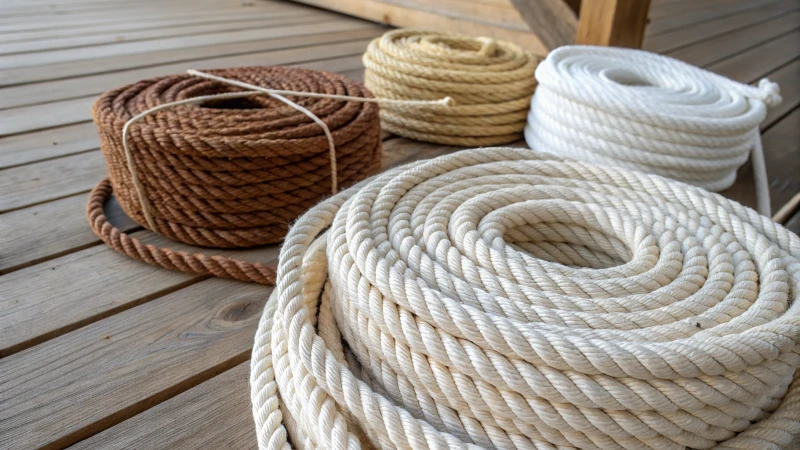
Influence of Material Properties on Strength
There was a time when I watched in awe as a high-rise construction project unfolded. I learned firsthand how ropes must endure immense stress without giving up. The choice of material becomes critical here—high-tensile alloys4, for instance, are a game-changer. They offer remarkable durability and load-bearing capacity, making them ideal for such demanding settings.
Flexibility and Weight Considerations
Flexibility is equally essential, especially in scenarios where ropes need to bend or move frequently. I recall a project where using compacted strands5 made the process smoother. These materials are engineered to deliver flexibility without compromising on weight, allowing for easy maneuvering while retaining their integrity.
| Material Type | Strength | Flexibility | Weight |
|---|---|---|---|
| High-Tensile Alloys | High | Moderate | Light |
| Compacted Strands | Moderate | High | Very Light |
Durability in Various Conditions
Having faced diverse environments, I've seen how factors like temperature and moisture can drastically affect rope lifespan. In marine or mining operations, using corrosion-resistant materials6 is non-negotiable. These environments demand ropes that can resist salt and moisture without faltering.
Cost vs. Performance Trade-offs
Every procurement decision involves balancing cost with performance. Premium materials like high-tensile alloys deliver exceptional performance but come with a price tag. It's essential to evaluate this cost-performance balance7 to ensure projects stay on track financially while meeting operational demands.
By considering these factors, one can select ropes that meet operational needs and budgetary constraints. This holistic approach is crucial for optimizing material choices in specific applications.
High-tensile alloys offer exceptional rope durability.True
High-tensile alloys are known for their superior strength and load-bearing capacity.
Compacted strands are heavier than high-tensile alloys.False
Compacted strands are actually lighter, providing high flexibility and low weight.
Why is understanding rope design crucial for high-rise applications?
Rope design isn't just about the materials—it's about ensuring safety and efficiency when you're dozens of stories high. I’ve learned firsthand how crucial it is to get this right.
Understanding rope design is essential for high-rise applications because it directly influences the safety, efficiency, and longevity of lifting systems. Properly designed ropes ensure optimal performance under stress, reducing risks in high-altitude work environments.
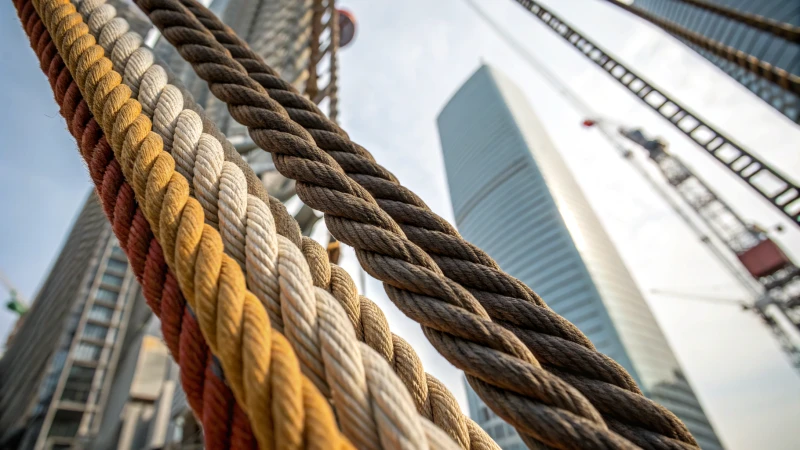
The Role of Rope Design in Safety
I've always found that when you're dealing with heights, safety becomes more than just a checklist; it's a lifeline. Rope design plays a pivotal role here. A well-thought-out design means these ropes can handle heavy loads, resist wear, and brave extreme weather conditions8. It's like having a trusted partner by your side, ensuring there's no breakage or slippage when it matters most.
Material Choices and Their Implications
Choosing the right material is like picking the perfect outfit for the weather. High-strength alloys or compacted strands often make the cut for their incredible tensile strength minus the weight penalty. These materials stand firm against corrosion9 and the elements, safeguarding structural integrity over time.
| Material Type | Advantages | Disadvantages |
|---|---|---|
| High-Tensile Alloys | Lightweight, strong | Costlier than standard materials |
| Compacted Strands | Increased strength, reduced diameter | May require specialized handling |
Impact on Efficiency and Maintenance
Think of a rope's design as the secret ingredient in a recipe for efficiency. Ropes that cut down on friction and slackness can transform elevator operations into a seamless glide, extending their lifespan. Multi-stage hoisting mechanisms, with their variable length ropes10, are like the chameleons of the system, adapting to reduce wear and conserve energy.
Innovations in Rope Technology
I’ve been amazed by how recent innovations have introduced smart sensors into ropes. Imagine having real-time updates on the rope's condition—it's like getting a health check-up without the doctor. These advancements underscore the importance of staying ahead with rope design11, paving the way for safer and more efficient high-rise operations.
By weighing these factors, folks like John or Emma can make well-informed choices that marry safety with efficiency, setting their projects on a path to success.
Rope design affects load-bearing capacity in high-rise applications.True
The design influences how well ropes can support loads, crucial for safety.
High-tensile alloys are heavier than standard materials.False
High-tensile alloys are lightweight yet strong, not heavier than standard materials.
How are innovations transforming rope efficiency?
Remember the last time you struggled with an unreliable rope on a project? Discover how new technologies are changing the game, making ropes more efficient and durable than ever.
Innovations in rope technology are now centered around high-tensile synthetic fibers and advanced coatings, which significantly enhance durability and reduce weight, thus boosting efficiency across various applications, from construction and rescue to climbing.
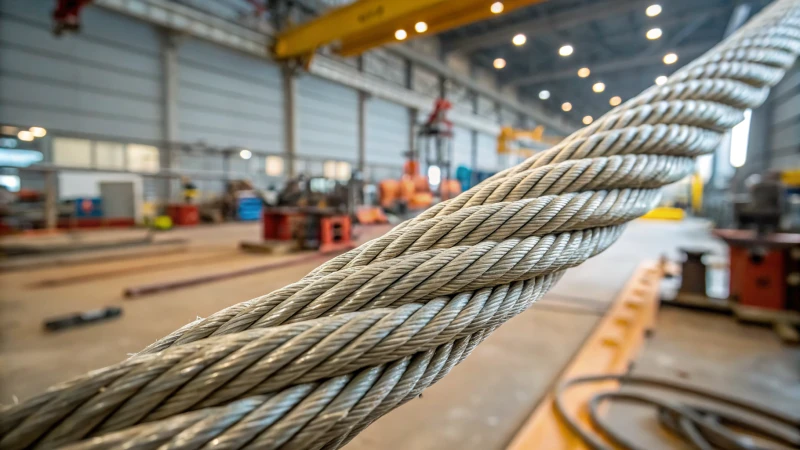
High-Tensile Synthetic Fibers
Have you ever found yourself in a situation where every ounce counted, like when you're lugging gear up a steep climb or coordinating a complex rescue mission? I know the feeling, and that's why these high-tensile synthetic fibers like Dyneema and Kevlar are such a game-changer. They're incredibly strong yet lightweight, making them perfect for those critical moments when you can't afford to be weighed down.
| Fiber | Strength (MPa) | Weight (g/m) |
|---|---|---|
| Dyneema | 3600 | 0.97 |
| Kevlar | 3620 | 1.44 |
These fibers have revolutionized construction projects12, where managing load capacity efficiently is crucial.
Advanced Coatings and Treatments
I remember working on a project near the coast where the harsh environment seemed to eat away at everything. That's when I truly appreciated advanced coatings like polyurethane or specialized wax treatments. These innovations protect ropes against abrasion, UV rays, and chemicals, extending their lifespan even in tough conditions. In marine applications13, where saltwater corrosion is a constant battle, these advancements are invaluable.
Multi-Stage Hoisting Mechanisms
If you've ever been involved in installing elevators in buildings with height restrictions, you'll know how crucial it is to optimize rope performance. Multi-stage hoisting mechanisms come into play here, allowing for variable rope lengths that minimize slack and friction. This is something I’ve seen make a real difference in modern elevator systems using compacted strand ropes to enhance efficiency while reducing maintenance.
Industrial sectors14 that embrace these mechanisms often see significant improvements in operational efficiency.
Lightweight Composite Materials
In my time working in the field, I've seen composite materials—combining traditional steel with synthetic fibers—become increasingly popular. These materials bring together the best of both worlds: the durability of steel and the lightness of synthetics. They're particularly beneficial in mining operations15 where conditions are extreme and reliability is non-negotiable.
Integrating these cutting-edge materials helps industries not only meet but exceed safety standards while boosting efficiency.
Dyneema ropes are heavier than Kevlar ropes.False
Dyneema ropes weigh 0.97 g/m, while Kevlar ropes weigh 1.44 g/m.
Advanced coatings enhance rope lifespan in harsh environments.True
Coatings like polyurethane improve resistance to abrasion and UV damage.
Conclusion
Overhead limitations significantly influence steel wire rope selection, affecting length, tensile strength, and material choice to ensure safety and efficiency in construction and heavy lifting applications.
-
This link provides insights into why tensile strength is crucial in heavy machinery applications. ↩
-
Explore why certain wire ropes are preferred in marine settings due to their corrosion resistance. ↩
-
Discover how multi-strand wire ropes offer flexibility and are suited for dynamic applications. ↩
-
Discover why high-tensile alloys are preferred for their exceptional durability and load-bearing capacity in demanding environments. ↩
-
Learn about how compacted strands offer flexibility and reduced weight, crucial for maneuverability and structural integrity. ↩
-
Explore materials that provide corrosion resistance, ideal for environments with moisture or salt exposure. ↩
-
Understand the balance between cost and performance to make informed procurement decisions. ↩
-
Understanding weather resistance helps in selecting ropes that perform well in diverse environmental conditions, crucial for high-rise safety. ↩
-
Learning about corrosion effects on ropes ensures selecting materials that extend rope lifespan, enhancing safety. ↩
-
Exploring variable length ropes reveals how they improve system efficiency by adapting to different heights. ↩
-
Discovering new rope technologies can lead to safer and more efficient high-rise operations with innovative features. ↩
-
Discover how high-tensile fibers improve load capacity and reduce weight in construction projects. ↩
-
Learn how coatings protect marine ropes from harsh environmental conditions. ↩
-
Understand how multi-stage hoisting reduces maintenance costs and improves efficiency. ↩
-
Explore why composite ropes are ideal for demanding mining conditions. ↩

